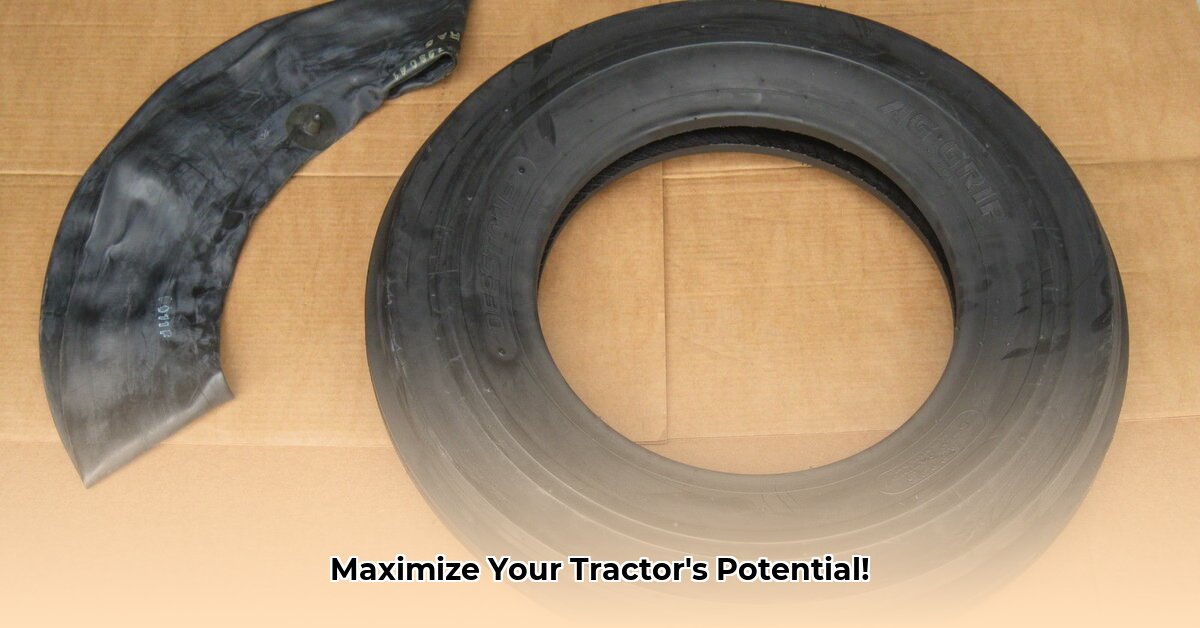
Choosing the right tractor tires is a crucial decision impacting both your farm's profitability and environmental sustainability. This guide focuses on 6.0 x 16 tractor tires, helping you navigate the options to maximize efficiency and minimize your environmental footprint. For more detailed information on 6.0 x 16 tires, check out this helpful resource: 6.0 x 16 tire guide.
The High Cost of Neglect: A Farmer's Story
Old McDonald, a seasoned farmer from Iowa, once faced escalating costs due to frequent tractor tire replacements. His older, cheaper tires wore out quickly, leading to high fuel consumption and significant downtime. By switching to more durable, fuel-efficient tires and adopting better maintenance practices, he saved thousands of dollars over a few years, demonstrating the significant return on investment that comes from informed tire selection. This story highlights the importance of understanding your tire options from a long-term perspective.
Decoding Your 6.0 x 16 Tractor Tire Options
The market offers many 6.0 x 16 tractor tires. Let's focus on key features to avoid getting bogged down in technical specifications:
Durability: A durable tire means fewer replacements and less downtime. Look for robust construction and read online reviews from other farmers. A longer-lasting tire, even with a higher initial cost, can save money over its lifetime. Isn't a longer lifespan worth a higher upfront investment?
Traction: The tread pattern impacts grip on different soil types. Choose tires optimized for your specific soil conditions (e.g., clay, loam, sandy). Optimal traction improves field performance and fuel efficiency.
Fuel Efficiency: Lower rolling resistance directly translates to lower fuel costs. Manufacturers provide rolling resistance data; compare this across models for significant long-term savings. Even a small improvement adds up significantly over time. How much could you save annually by choosing a fuel-efficient tire?
Price: While the initial cost is important, it's only part of the equation. We’ll calculate the total cost of ownership (TCO) to get the whole picture.
Calculating Total Cost of Ownership (TCO): A Step-by-Step Guide
TCO isn't simply the initial purchase price; it encompasses all costs over a tire's lifespan:
Initial Cost: The upfront purchase price.
Fuel Consumption: Estimate annual fuel savings based on improved fuel efficiency (data often provided by manufacturers). Multiply this by your fuel price per gallon for annual savings.
Maintenance: Include annual costs for inspections, rotations, and potential repairs.
Replacement Cost: Divide the tire's replacement cost by its estimated lifespan (in years) to obtain the annual replacement cost.
Disposal Costs: Factor in the cost of proper tire recycling or disposal.
TCO Calculation: Sum the annual costs (steps 2-5) and add the initial cost (step 1). This total represents your TCO. Remember, this is an estimate; accurate data requires careful record-keeping.
Extending the Life of Your 6.0 x 16 Tractor Tires: Maintenance is Key
Proper maintenance significantly extends tire lifespan and reduces costs:
Regular Pressure Checks: Use an accurate gauge and inflate to the sidewall's recommended pressure. Underinflation increases wear and fuel consumption.
Frequent Inspections: Examine tires for cuts, bulges, embedded objects, and unusual wear. Address issues promptly to prevent further damage.
Tire Rotation: Rotate tires periodically (follow manufacturer recommendations) for even wear.
Proper Storage: Store tires correctly during off seasons to prevent damage.
Sustainable Disposal: The Responsible Choice
Avoid illegal dumping; it harms the environment. Consider:
Recycling: Many tire dealers offer recycling programs.
Retreading: In some cases, retreading extends tire life significantly. Check with local service providers.
Choosing sustainable tires isn't simply about environmental consciousness – it's a smart financial decision. By performing a TCO analysis and implementing diligent maintenance, you'll improve your farm's bottom line and contribute to environmental sustainability. Remember that ongoing research improves tire technology and sustainability measures, so stay informed about new developments in the field.
Key Takeaways for Sustainable Tire Management
- Choosing the right tires significantly impacts your farm's profitability and environmental footprint.
- Total cost of ownership (TCO) analysis goes beyond the initial purchase price, encompassing fuel consumption, maintenance, and replacement costs.
- Proper tire maintenance and sustainable disposal practices are critical for long-term cost savings and environmental stewardship.